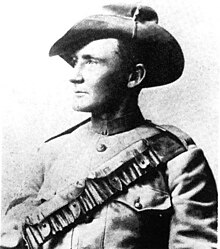
Back Breaker Morant Afrikaans Breaker Morant German Breaker Morant French Breaker Morant Irish 파괴자 모랜트 Korean Breaker Morant Dutch Breaker Morant Portuguese Breaker Morant Romanian Объездчик Морант Russian
This article needs additional citations for verification. (January 2024) |
Harry Harbord Morant | |
|---|---|
 Harry "The Breaker" Harbord Morant | |
| Born | Edwin Henry Murrant 9 December 1864 Bridgwater, Somerset, UK |
| Died | 27 February 1902 (aged 37) |
| Cause of death | Execution by firing squad |
| Resting place | Church Street Cemetery, Pretoria, South Africa |
| Criminal status | Executed |
| Spouse | Daisy May O'Dwyer (1884; quickly separated) |
| Conviction(s) | Murder (12 counts) |
| Trial | Court-martial of Breaker Morant |
| Criminal penalty | Death |
| Details | |
| Victims | 12 |
Span of crimes | August – 7 September 1901 |
| Country | South African Republic |
| Target(s) | POWs and civilians |
| Military career | |
| Nickname(s) | The Breaker |
| Allegiance | British Empire |
| Years of service | 1899–1902 |
| Rank | Lieutenant |
| Unit | South Australian Mounted Rifles Bushveldt Carbineers |
| Battles/wars | Second Boer War |
Harry Harbord Morant (born Edwin Henry Murrant, 9 December 1864 – 27 February 1902), better known as Breaker Morant, was an English horseman, bush balladist, military officer, and war criminal who was convicted and executed for murdering nine prisoners-of-war (POWs) and three captured civilians in three separate incidents during the Second Boer War.
Morant travelled to the Australian colonies in 1883 and for more than fifteen years he worked in a variety of occupations in Queensland, New South Wales and South Australia, during which time he developed a reputation as a horseman and bush balladist. In 1899 he enlisted in the second contingent of the South Australian Mounted Rifles to be sent by the government of that colony to serve as part of the British Empire forces fighting in South Africa during the Second Boer War. Morant embarked as a corporal and ended his term of service as a sergeant, having spent much of his time as a despatch rider. He then returned to England for six months while he unsuccessfully sought to clear some debts.
Returning to South Africa, Morant received a commission as a lieutenant with an irregular regiment – the Bushveldt Carbineers. He was arrested and court-martialled for committing murder on active service – one of the first such prosecutions in British military history. According to military prosecutors, Morant retaliated for the death in combat of his squadron commander – a close friend – with a series of revenge killings against both Boer POWs and many civilian residents of the Northern Transvaal. Morant's defence attorney, Major James Francis Thomas, asserted that his clients should be acquitted, claiming that they were acting in accordance with superior orders not to take prisoners. Despite this, Thomas was unable to establish that an order to that effect had been issued.
Morant was accused of the summary execution of Floris Visser, a wounded POW, and the slaying of four Afrikaners and four Dutch schoolteachers who had surrendered at the Elim Hospital, five of whom were members of the Soutpansberg Commando. Morant was found guilty and sentenced to death. Morant and Lieutenant Peter Handcock were then court-martialled for the murder of the Reverend Carl August Daniel Heese, a South African-born Minister of the Berlin Missionary Society. Heese had spiritually counselled the Dutch and Afrikaner victims at Elim Hospital and had been shot to death the same afternoon. Morant and Handcock were acquitted of the Heese murder, but their sentences for murdering Visser, the eight victims at Elim Hospital, and three others were implemented by a firing squad from the Cameron Highlanders on 27 February 1902.
Morant and Handcock have become folk heroes in modern Australia, representing a turning point for Australians' self-determination and independence from British rule. Their court-martial and death have been the subject of books, a stage play and an award-winning Australian New Wave film by director Bruce Beresford. Upon its release during 1980, Beresford's film both brought Morant's life story to a worldwide audience and "hoisted the images of the accused officers to the level of Australian icons and martyrs".[1] Despite the seriousness of the evidence and charges against them, some modern Australians regard Morant and Handcock as scapegoats or even as victims of judicial murder. They continue to attempt, with some public support, to obtain a posthumous pardon or even a new trial.
According to South African historian Charles Leach, "In the opinion of many South Africans, particularly descendants of victims as well as other involved persons in the far Northern Transvaal, justice was only partially achieved by the trial and the resultant sentences. The feeling still prevails that not all the guilty parties were dealt with – the notorious Captain Taylor being the most obvious one of all."[2]
- ^ Leach 2012, p. xxxii.
- ^ Leach 2012, p. 139.